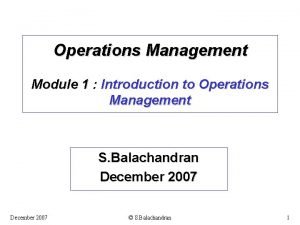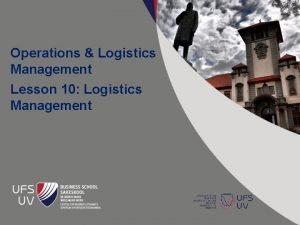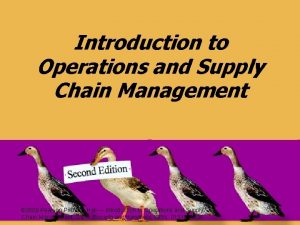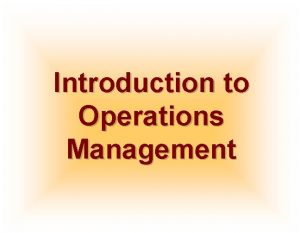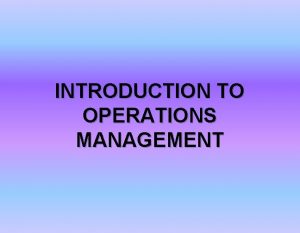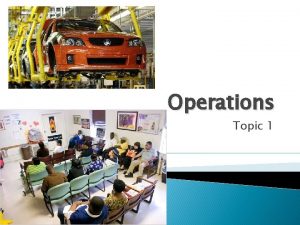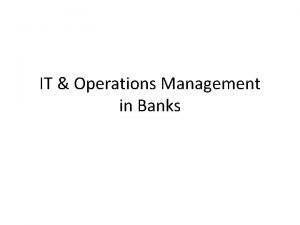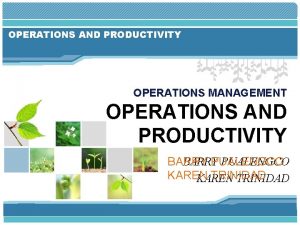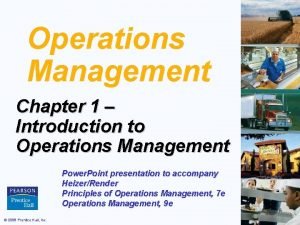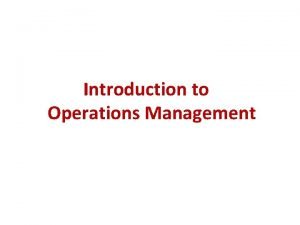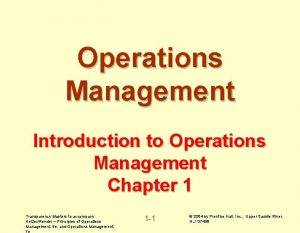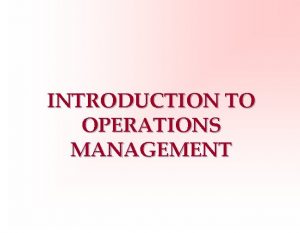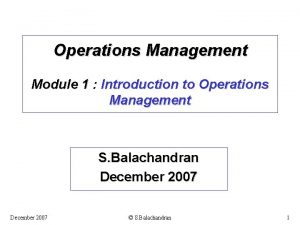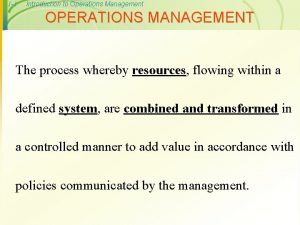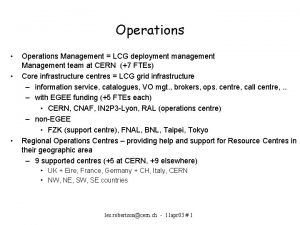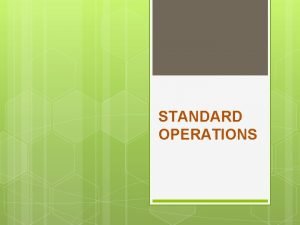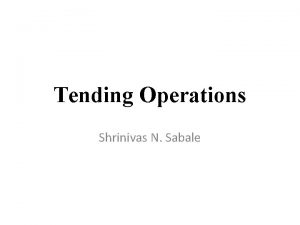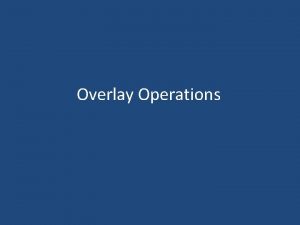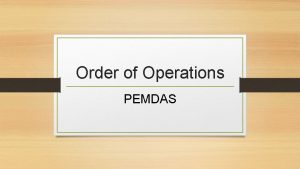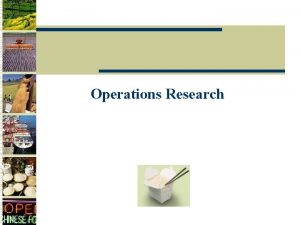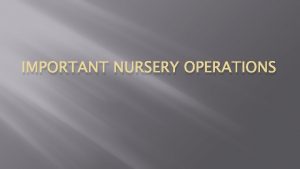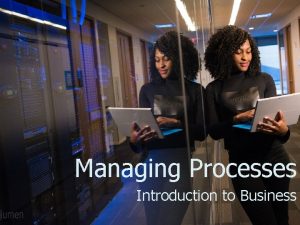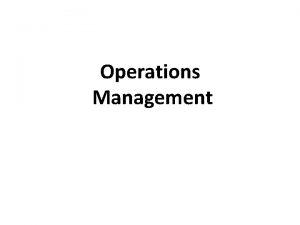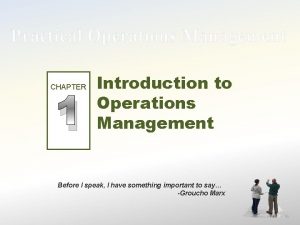Introduction to Operations Management Operations Management is The









































- Slides: 41

Introduction to Operations Management

Operations Management is: The business function responsible for planning, coordinating, and controlling the resources needed to produce products and services for a company 2

Operations Management is: • A management function • An organization’s core function • In every organization whether Service or Manufacturing, profit or Not for profit 3

Typical Organization Chart © Wiley 2010 4

What is Role of OM? • OM Transforms inputs to outputs – Inputs are resources such as • People, Material, and Money – Outputs are goods and services 5

OM’s Transformation Process 6

Transformation Process of a Can Food Processor Inputs • Raw vegetables • Metal sheets • Water • Energy • Labor • Building • Equipment Processing • Cleaning • Making cans • Cutting • Cooking • Packing • Labeling Outputs Canned vegetabl es

Transformation Process of a Hos Inputs • Doctors, nurses • Hospital • Medical Supplies • Equipment • Laboratories Processing Outputs • Examination. Healthy patients • Surgery • Monitoring • Medication • Therapy

OM’s Transformation Role • To add value – Increase product value at each stage – Value added is the net increase between output product value and input material value • Provide an efficient transformation – Efficiency – means performing activities well for least possible cost 9

Types of Transformation Processes Physical- manufacturing Locational- transportation Exchange- retailing Storage- warehousing Physiological- health care Informationaltelecommunications Psychological- entertainment

OM Decisions © Wiley 2010 12

The Historical Evolution of Operations Management

Significant Events in Operations Management

Business Information Flow 15

Business Functions Overlap Operatio ns Marketi ng Finan ce

Business Functions - Bank (1 of 3) Commercial Bank © 1984 -1994 T/Maker Co. Marketing Teller Scheduling Operations Check Clearing Finance/ Accounting Transactions Processing Security

Business Functions – Airline (2 of 3) Airline Marketing Flight Operatio ns Operations Ground Support Facility Maintenanc e Finance/ Accounti ng Catering

Business Functions – Manufacturer (3 of 3) Manufacturing Marketing Manufacturing Operations Production Control Finance/ Accounting Quality Control Purchasin g

New Concepts and Trends in OM Mass Customization Supply Chain Management Outsourcing Lean manufacturing Agility Electronic Commerce

New Concepts and Trends(1 of 6): Mass Customization The rapid, low cost production of goods and services that fulfill constantly changing and increasingly unique customer desires.

New Concepts and Trends (2 of 6): Supply Chain Management The management of the sequence of organizations- their facilities, functions and activities- that are involved in producing and delivering a product or service SCM requires the application of a systems approach to managing the flow of information, materials and services from raw material suppliers through factories and warehoses to the end user (customer)

Simple Product Supply Chain Suppliers’ Suppliers Direct Suppliers Producer Distributor Final Consumer

New Concepts and Trends (3 of 6) : Outsourcing Buying goods or services rather than producing goods or performing services within the organization

New Concepts and Trends (4 of 6): Lean Manufacturing Systems that use minimal amounts of resources - less space, less inventory, fewer workers, fewer levels of management- to produce a high volume of high-quality goods with some variety

New Concepts and Trends (5 of 6): Agility The ability of an organization to respond quickly to demands or opportunities. Involves maintaining a flexible system that can quickly respond to changes in either the volume of demand or changes in product/service offerings

New Concepts and Trends (6 of 6): Electronic Commerce The use of computer networks, primarily the internet, to buy and sell products, services, and information.

Other Trends Project Management (PERT, CPM) Management of Technology and Information Systems (GPS, ERP) Quality and Process Improvements (Six Sigma)

Social Responsibility & Ethics

Law and Ethics • Ethics – A set of moral principles or values that governs the conduct of an individual or a group. • What is lawful conduct is not always ethical conduct. – The law may permit something that would be ethically wrong.

What is ethical? • Is it legal? • Does it cause physical/psychological harm to anyone? • Is it ok if everyone knows about it? • Can “I” live with it for my whole life? ?

Theories of Social Responsibility Maximizing Profits Corporate Citizenship Moral Minimum Stakeholder Interest

Maximizing Profits • A theory of social responsibility that says a corporation owes a duty to take actions that maximize profits for shareholders.

Moral Minimum • A theory of social responsibility that says a corporation’s duty is to make a profit while avoiding harm to others. • As long as business avoids or corrects the social injury it causes, it has met its duty of social responsibility.

Moral Minimum • The legislative and judicial branches of government have established laws that enforce the moral minimum of social responsibility on corporations. – e. g. , Occupational safety laws – e. g. , Consumer protection laws for product safety

Stakeholder Interest • A theory of social responsibility that says a corporation must consider the effects its actions have on persons other than its stockholders. • This theory is criticized because it is difficult to harmonize the conflicting interests of stakeholders.

Corporate Citizenship • A theory of responsibility that says a business has a responsibility to do good for the society. • Business is responsible for helping to solve social problems.

Entrepreneurship & Intrapreneurship

Introduction to Entrepreneurship There is tremendous interest in entrepreneurship around the world According to the GEM 2005 study, about 330 million people, or 14% of the adults in the 35 countries surveyed, are involved in forming new businesses

What is Entrepreneurship? • Capacity to take risks • Ability to own and organize • Desire and capability to innovate and diversify

Who is an entrepreneur? • Person conducting own business (Webster) • Person who sets up business deals in order to make profits (Collins Cobuild) • Organizer of an economic venture, one who owns, organizes, manages, and assumes the risks of the business (Chandrashekhar)

Why Become an Entrepreneur? There are three primary reasons that people become entrepreneurs and start their own firms Desire to be their own boss Desire to pursue their own ideas Financial rewards
 Operation management module
Operation management module Introduction to operations and supply chain management
Introduction to operations and supply chain management Role of operations management
Role of operations management Introduction to operations and supply chain management
Introduction to operations and supply chain management Hình ảnh bộ gõ cơ thể búng tay
Hình ảnh bộ gõ cơ thể búng tay Ng-html
Ng-html Bổ thể
Bổ thể Tỉ lệ cơ thể trẻ em
Tỉ lệ cơ thể trẻ em Gấu đi như thế nào
Gấu đi như thế nào Glasgow thang điểm
Glasgow thang điểm Hát lên người ơi
Hát lên người ơi Môn thể thao bắt đầu bằng chữ đua
Môn thể thao bắt đầu bằng chữ đua Thế nào là hệ số cao nhất
Thế nào là hệ số cao nhất Các châu lục và đại dương trên thế giới
Các châu lục và đại dương trên thế giới Công của trọng lực
Công của trọng lực Trời xanh đây là của chúng ta thể thơ
Trời xanh đây là của chúng ta thể thơ Cách giải mật thư tọa độ
Cách giải mật thư tọa độ Làm thế nào để 102-1=99
Làm thế nào để 102-1=99 Phản ứng thế ankan
Phản ứng thế ankan Các châu lục và đại dương trên thế giới
Các châu lục và đại dương trên thế giới Thể thơ truyền thống
Thể thơ truyền thống Quá trình desamine hóa có thể tạo ra
Quá trình desamine hóa có thể tạo ra Một số thể thơ truyền thống
Một số thể thơ truyền thống Bàn tay mà dây bẩn
Bàn tay mà dây bẩn Vẽ hình chiếu vuông góc của vật thể sau
Vẽ hình chiếu vuông góc của vật thể sau Thế nào là sự mỏi cơ
Thế nào là sự mỏi cơ đặc điểm cơ thể của người tối cổ
đặc điểm cơ thể của người tối cổ Giọng cùng tên là
Giọng cùng tên là Vẽ hình chiếu đứng bằng cạnh của vật thể
Vẽ hình chiếu đứng bằng cạnh của vật thể Vẽ hình chiếu vuông góc của vật thể sau
Vẽ hình chiếu vuông góc của vật thể sau Thẻ vin
Thẻ vin đại từ thay thế
đại từ thay thế điện thế nghỉ
điện thế nghỉ Tư thế ngồi viết
Tư thế ngồi viết Diễn thế sinh thái là
Diễn thế sinh thái là Các loại đột biến cấu trúc nhiễm sắc thể
Các loại đột biến cấu trúc nhiễm sắc thể Số nguyên tố là số gì
Số nguyên tố là số gì Tư thế ngồi viết
Tư thế ngồi viết Lời thề hippocrates
Lời thề hippocrates Thiếu nhi thế giới liên hoan
Thiếu nhi thế giới liên hoan ưu thế lai là gì
ưu thế lai là gì Hổ đẻ mỗi lứa mấy con
Hổ đẻ mỗi lứa mấy con
